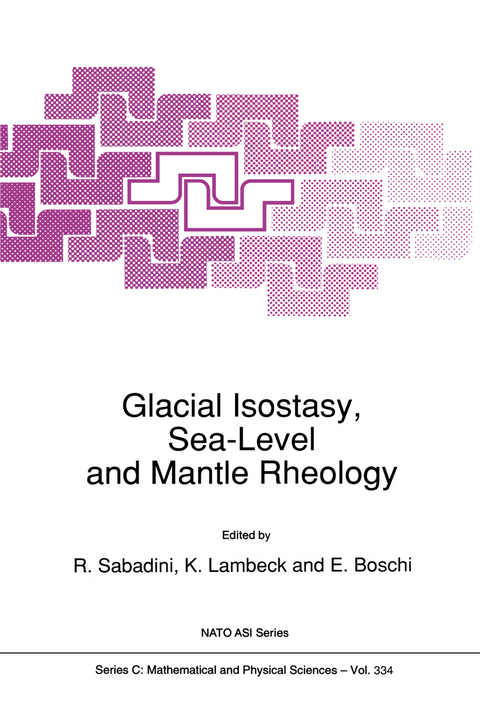
Glacial Isostasy, Sea-Level and Mantle Rheology
Springer (Verlag)
978-94-010-5492-8 (ISBN)
by K. Lambeck, R. Sabadini and E. B08Chi Viscosity is one of the important material properties of the Earth, controlling tectonic and dynamic processes such as mantle convection, isostasy, and glacial rebound. Yet it remains a poorly resolved parameter and basic questions such as whether the planet's response to loading is linear or non-linear, or what are its depth and lateral variations remain uncertain. Part of the answer to such questions lies in laboratory observations of the rheology of terrestrial materials. But the extrapolation of such measurements from the laboratory environment to the geological environment is a hazardous and vexing undertaking, for neither the time scales nor the strain rates characterizing the geological processes can be reproduced in the laboratory. General rules for this extrapolation are that if deformation is observed in the laboratory at a particular temperature, deformation in geological environments will occur at a much reduced temperature, and thatif at laboratory strain rates a particular deformation mechanism dominates over all others, the relative importance of possible mechanisms may be quite different at the geologically encountered strain rates. Hence experimental results are little more than guidelines as to how the Earth may respond to forces on long time scales.
Post-Glacial Rebound.- “Rheology of mantle and lithosphere inferred 1 from post-glacial uplift in Fennoscandia”.- “Deep continental roots: the 21 effects of lateral variations of viscosity on post-glacial rebound”.- “A model for Devensian and Flandrian glacial rebound and sea-level change in Scotland”.- “Radial resolution in the inference of mantle viscosity from observations of glacial isostatic adjustment”.- “Late Pleistocene and Holocene sea-level change; evidence for lateral mantle viscosity structure?”.- “The ICE-3G model of late Pleistocene deglaciation: construction, verification and applications”.- “The dynamical influences of a hard transition zone on post-glacial uplifts and rotational signatures”.- Glaciology and Climatology.- “Relative Sea Levels, Northeastern margin of the Laurentide ice sheet, on timescales of 103 and 102 A”.- “Changing Ice loads on the Earth’s surface during the last glaciation cycle”.- “Global warming expected from increase of greenhouse gases: a forcing for sea level change”.- Sea-Level Fluctuations.- “The study of inferred patterns of Holocene sea-level change from Atlantic and other European coastal margins as a means of testing models of Earth crustal behavior”.- “Secular sea-level change”.- “A survey of relative sea-level changes observed during the Holocene”.- “Constraints on long-period sea level variations from global tide gauge data”.- “Coastal submergence of the Netherlands, NW Brittany (Prance), Delmarva Peninsula (VA, USA), and Connecticut (USA) during the last 5500 to 7500 sidereal years”.- Mantle Rheology.- “Threedimensional rheology”.- “Mantle viscosity: what are we exactly looking for?”.- “The microphysical approach to mantle rheology”.- Mantle and Lithospheric Dynamics.- “Chemical boundaries in the mantle”.- “Crustal deformation due to aseismic slip on buried faults”.- “Gross Earth data and mantle convection: new inferences of mantle viscosity”.- “Continental flooding and mantle-lithosphere dynamics”.- “Mantle viscosity: a comparison of models from postglacial rebound and from the geoid, plate driving forces, and advected heat flux”.- “Joint determination of lateral heterogeneity and earthquake location”.- “Toroidal-poloidal partitioning of lithospheric plate motions”.- “Seismic imaging, plate velocities and geoid: the direct and inverse problem”.- “Hotspots and the case for a high viscosity lower mantle”.- “Perturbations in the Earth’s rotation induced by internal density anomalies: implications for sea-level fluctuations”.- “Variable viscosity convection in a compressible upper mantle and the thickness of continental lithosphere”.- “Continental evolution and archaeo-sea-levels”.- “Dynamical influences of pressure-dependent thermal expansivity on mantle convection”.- Discussion and recommendations.
| Reihe/Serie | NATO Science Series C ; 334 |
|---|---|
| Zusatzinfo | XIII, 708 p. |
| Verlagsort | Dordrecht |
| Sprache | englisch |
| Maße | 155 x 235 mm |
| Themenwelt | Naturwissenschaften ► Biologie ► Ökologie / Naturschutz |
| Naturwissenschaften ► Geowissenschaften ► Geologie | |
| Naturwissenschaften ► Geowissenschaften ► Geophysik | |
| Naturwissenschaften ► Geowissenschaften ► Hydrologie / Ozeanografie | |
| Naturwissenschaften ► Physik / Astronomie ► Angewandte Physik | |
| Technik ► Umwelttechnik / Biotechnologie | |
| ISBN-10 | 94-010-5492-4 / 9401054924 |
| ISBN-13 | 978-94-010-5492-8 / 9789401054928 |
| Zustand | Neuware |
| Informationen gemäß Produktsicherheitsverordnung (GPSR) | |
| Haben Sie eine Frage zum Produkt? |
aus dem Bereich


